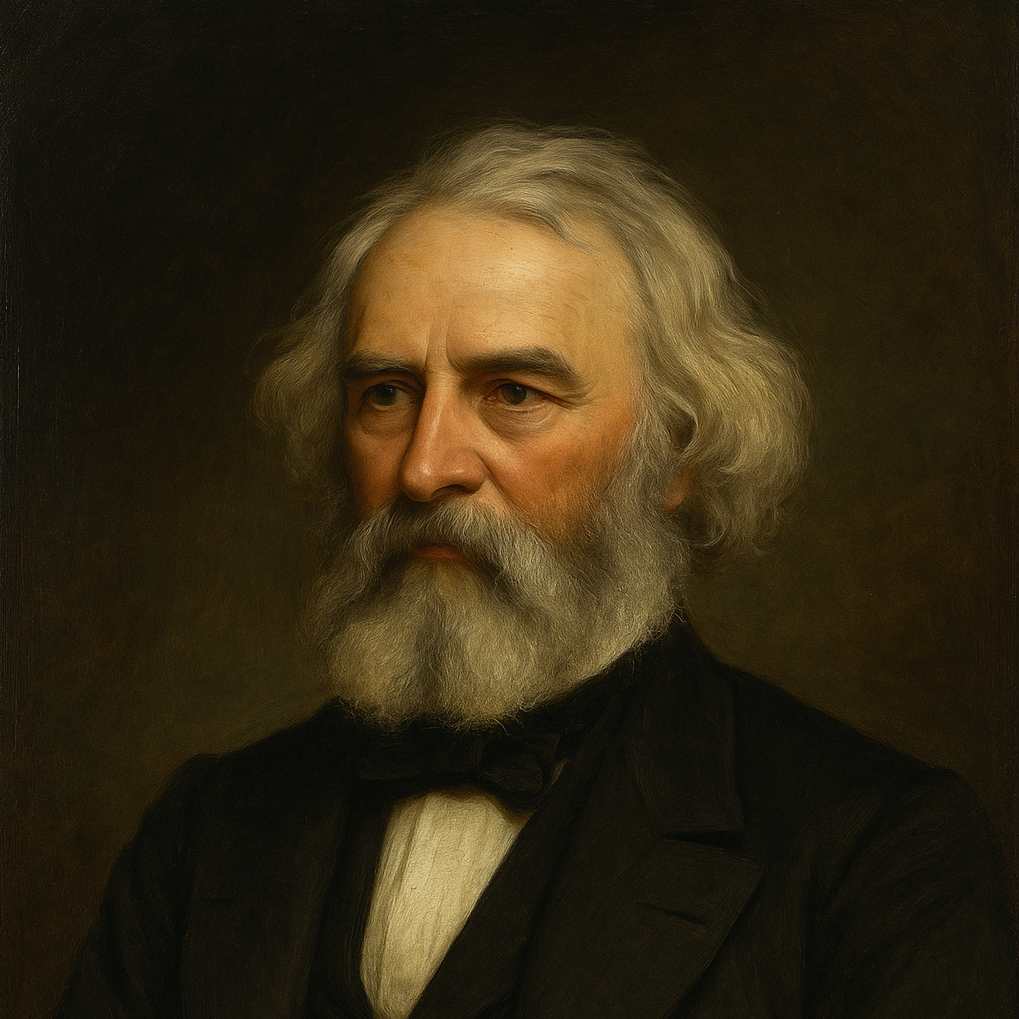Loss and Gain
Henry Wadsworth Longfellow
1807 to 1882

When I compare
What I have lost with what I have gained,
What I have missed with what attained,
Little room do I find for pride.
I am aware
How many days have been idly spent;
How like an arrow the good intent
Has fallen short or been turned aside.
But who shall dare
To measure loss and gain in this wise?
Defeat may be victory in disguise;
The lowest ebb is the turn of the tide.
Henry Wadsworth Longfellow's Loss and Gain
Introduction
Henry Wadsworth Longfellow's poem "Loss and Gain" presents a profound meditation on the human experience of success and failure, progress and regress. Through its concise yet powerful lines, Longfellow invites readers to reflect on their own lives and question the very nature of achievement and disappointment. This essay will delve into the intricate layers of meaning woven throughout the poem, examining its structure, literary devices, themes, and broader philosophical implications.
Structure and Form
The poem consists of three quatrains, each following an ABBA rhyme scheme. This structure lends a sense of symmetry and balance to the piece, mirroring the theme of comparison that runs throughout. The consistent meter, predominantly iambic tetrameter with occasional variations, creates a rhythmic flow that guides the reader through the poet's contemplation.
Longfellow's choice of form is particularly significant when considering the poem's content. The balanced structure serves as a counterpoint to the speaker's internal conflict, suggesting that even in moments of doubt and self-reflection, there is an underlying order to our experiences.
Literary Devices and Imagery
Longfellow employs a variety of literary devices to enhance the poem's impact. The opening line, "When I compare," immediately establishes the reflective tone and introduces the central metaphor of weighing one's accomplishments against one's failures. This scale imagery persists throughout the poem, creating a visual representation of the speaker's internal struggle.
The use of parallelism in the first stanza ("What I have lost with what I have gained, / What I have missed with what attained") reinforces the theme of comparison and creates a rhythmic balance that echoes the poem's content. This parallelism also serves to emphasize the duality of human experience, where every gain is accompanied by a loss, and every achievement is shadowed by missed opportunities.
Longfellow's imagery becomes more dynamic in the second stanza, where he introduces the metaphor of an arrow: "How like an arrow the good intent / Has fallen short or been turned aside." This vivid image captures the frustration of unrealized potential and the way our best intentions can often go astray. The arrow metaphor also suggests a sense of momentum and direction, implying that even our failures are part of a larger journey.
In the final stanza, Longfellow employs nautical imagery with "The lowest ebb is the turn of the tide." This powerful metaphor serves multiple purposes. It suggests the cyclical nature of success and failure, the inevitability of change, and the hope that exists even in our darkest moments. The tide imagery also expands the poem's scope, moving from the personal reflections of the earlier stanzas to a more universal perspective on the human condition.
Thematic Analysis
At its core, "Loss and Gain" is a meditation on the nature of success, failure, and the human tendency to judge our own worth based on our accomplishments. The speaker's initial comparison leads to a somber conclusion: "Little room do I find for pride." This line reveals a deep-seated insecurity and self-doubt, common to many who engage in such introspection.
The second stanza elaborates on this sense of disappointment, acknowledging wasted time and unfulfilled potential. The phrase "idly spent" carries connotations of regret and missed opportunities, while the image of the misdirected arrow poignantly captures the gap between intention and outcome.
However, the final stanza marks a significant shift in tone and perspective. The rhetorical question "But who shall dare / To measure loss and gain in this wise?" challenges the very premise of the poem's opening lines. Longfellow suggests that our human attempts to quantify success and failure are fundamentally flawed and potentially misleading.
The concluding lines, "Defeat may be victory in disguise; / The lowest ebb is the turn of the tide," offer a profound reframing of the concept of failure. Longfellow posits that what we perceive as defeat may, in fact, be the precursor to great success. This idea resonates with many philosophical and spiritual traditions that view adversity as a catalyst for growth and transformation.
Philosophical Implications
"Loss and Gain" touches on several philosophical concepts that have long preoccupied human thought. The poem grapples with the subjective nature of success and failure, questioning our ability to accurately assess our own achievements and setbacks. This skepticism towards self-judgment aligns with philosophical traditions that emphasize the limitations of human perception and understanding.
Moreover, the poem's final stanza introduces a perspective that resonates with existentialist thought. By challenging the conventional understanding of victory and defeat, Longfellow suggests that meaning and value are not inherent in our experiences but are instead created through our interpretation of them. This idea echoes existentialist concepts of radical freedom and the responsibility of individuals to create meaning in their lives.
The cyclical imagery of the tide also evokes concepts of eternal recurrence found in various philosophical and religious traditions. This perspective encourages readers to view their lives not as a linear progression towards success or failure, but as part of a larger, ever-changing pattern of existence.
Historical and Literary Context
To fully appreciate "Loss and Gain," it is essential to consider Longfellow's place in American literary history. As one of the most popular poets of the 19th century, Longfellow was known for his accessible style and his ability to address universal themes in a way that resonated with a broad audience.
This poem, with its focus on personal reflection and moral questioning, aligns with the introspective tendencies of Romantic poetry. However, its concise form and clear imagery also foreshadow the more direct and imagistic approach of modernist poetry that would emerge in the early 20th century.
Longfellow's exploration of success and failure in "Loss and Gain" can also be read in the context of 19th-century American culture, which was characterized by rapid change, expansion, and a growing emphasis on individual achievement. The poem's nuanced take on these themes offers a counterpoint to the prevailing narratives of progress and success that dominated much of the discourse of Longfellow's time.
Relevance and Universal Appeal
Despite being written over a century ago, "Loss and Gain" remains remarkably relevant to contemporary readers. In our current cultural climate, which often emphasizes external markers of success and constant self-improvement, Longfellow's words offer a valuable perspective on the nature of achievement and the importance of resilience in the face of perceived failure.
The poem's message about the potential hidden value in defeat is particularly resonant in fields ranging from business to education, where failure is increasingly recognized as an essential part of the learning process. Longfellow's insight that "Defeat may be victory in disguise" anticipates modern attitudes towards failure as a potential catalyst for growth and innovation.
Furthermore, the poem's emphasis on the cyclical nature of experience speaks to the increasing recognition of the importance of mental health and well-being. The idea that low points are not permanent, but rather part of a larger cycle, offers comfort and hope to those struggling with personal or professional challenges.
Conclusion
Henry Wadsworth Longfellow's "Loss and Gain" is a masterful exploration of the human experience of success and failure. Through its carefully crafted structure, vivid imagery, and profound thematic content, the poem invites readers to reconsider their understanding of achievement and disappointment.
Longfellow's work transcends its historical context to offer insights that remain deeply relevant to contemporary audiences. By challenging our tendency to judge ourselves harshly and encouraging a more nuanced view of success and failure, "Loss and Gain" provides a valuable perspective on how we navigate the ups and downs of life.
Ultimately, the poem's enduring power lies in its ability to transform our understanding of our own experiences. In encouraging us to see potential victory in apparent defeat and to recognize the turning of the tide in our lowest moments, Longfellow offers not just poetic beauty, but practical wisdom for living a more balanced and resilient life.
This text was generated by AI and is for reference only. Learn more
Want to join the discussion? Reopen or create a unique username to comment. No personal details required!



Comments
No comments yet. Be the first to comment!